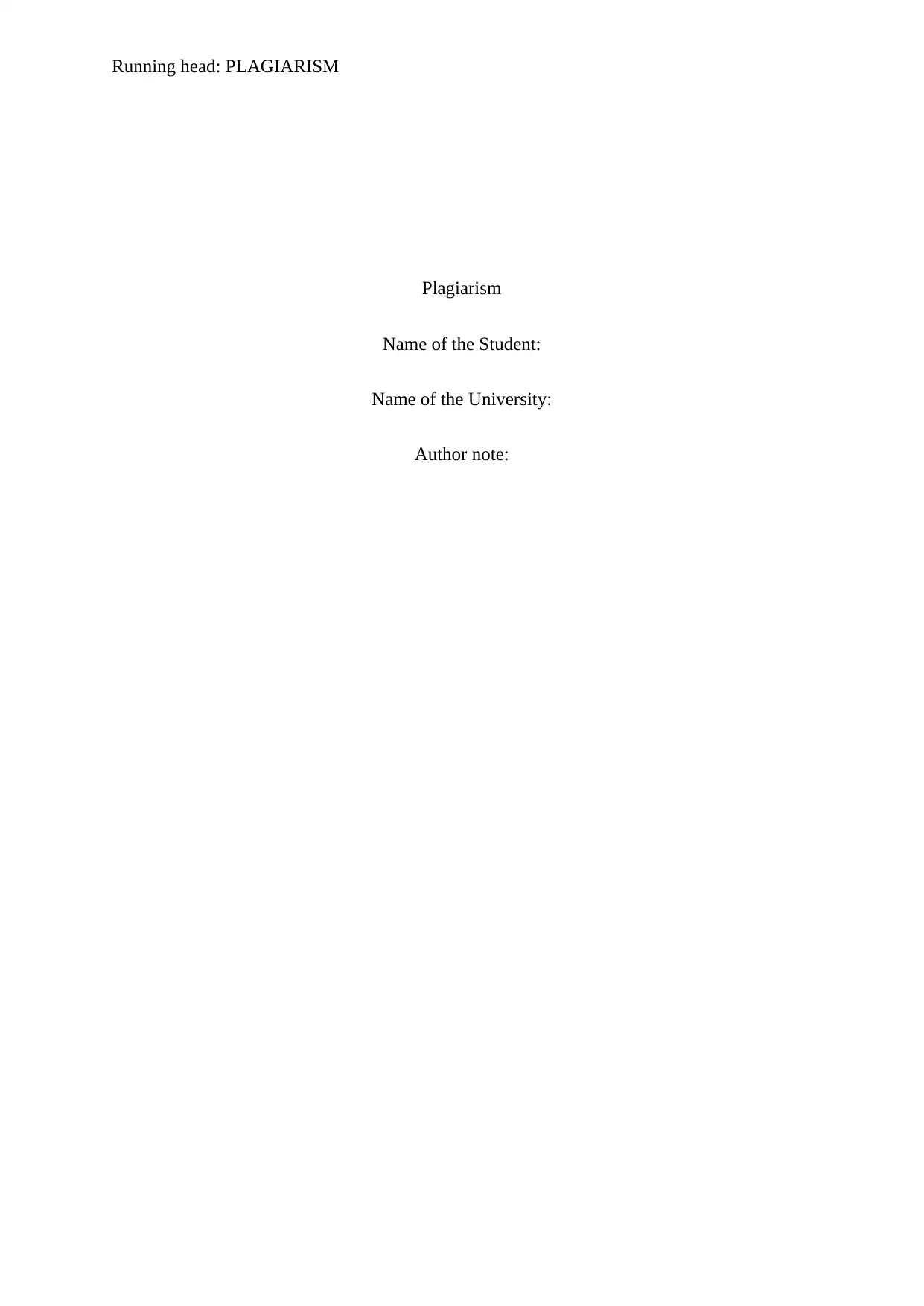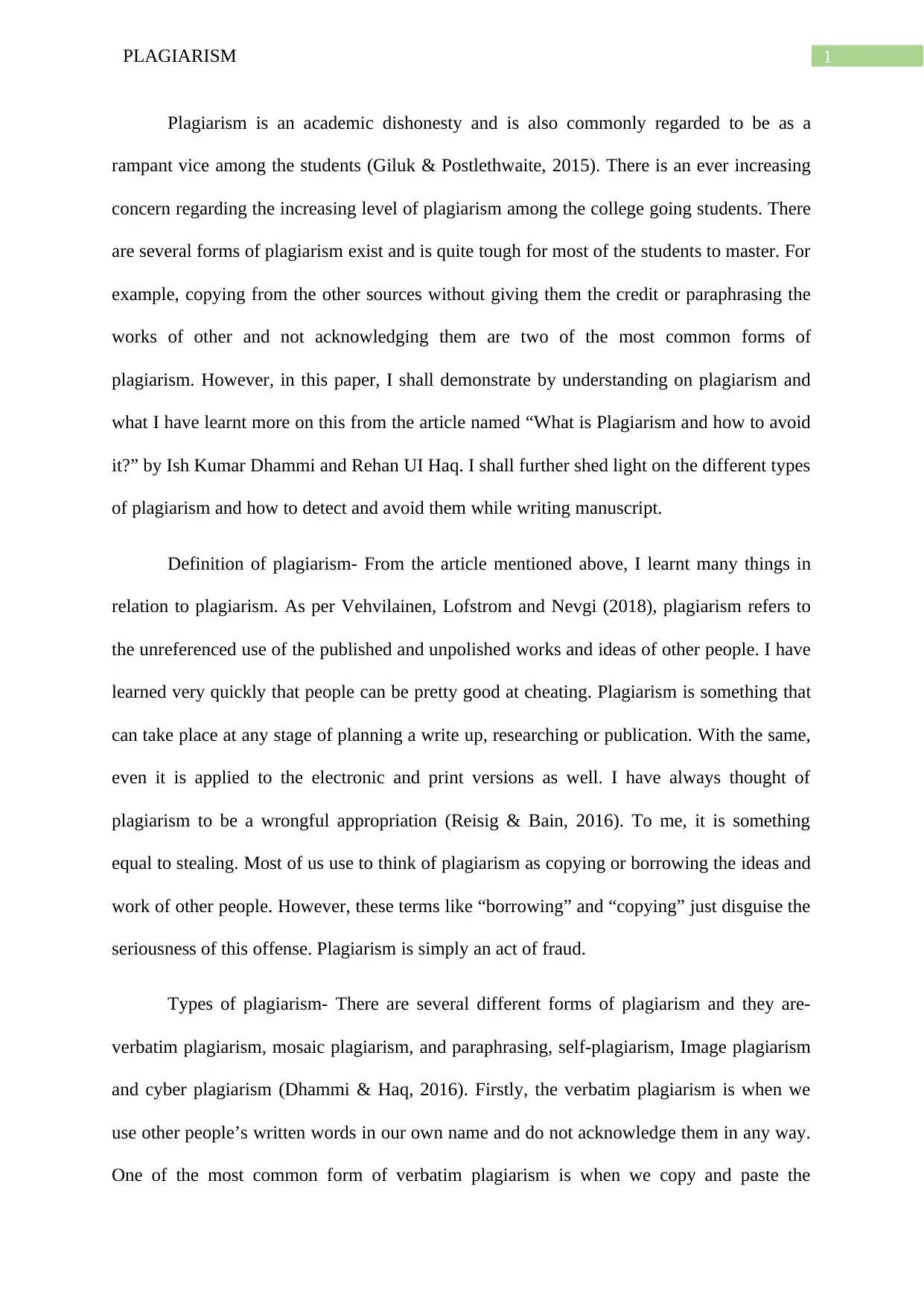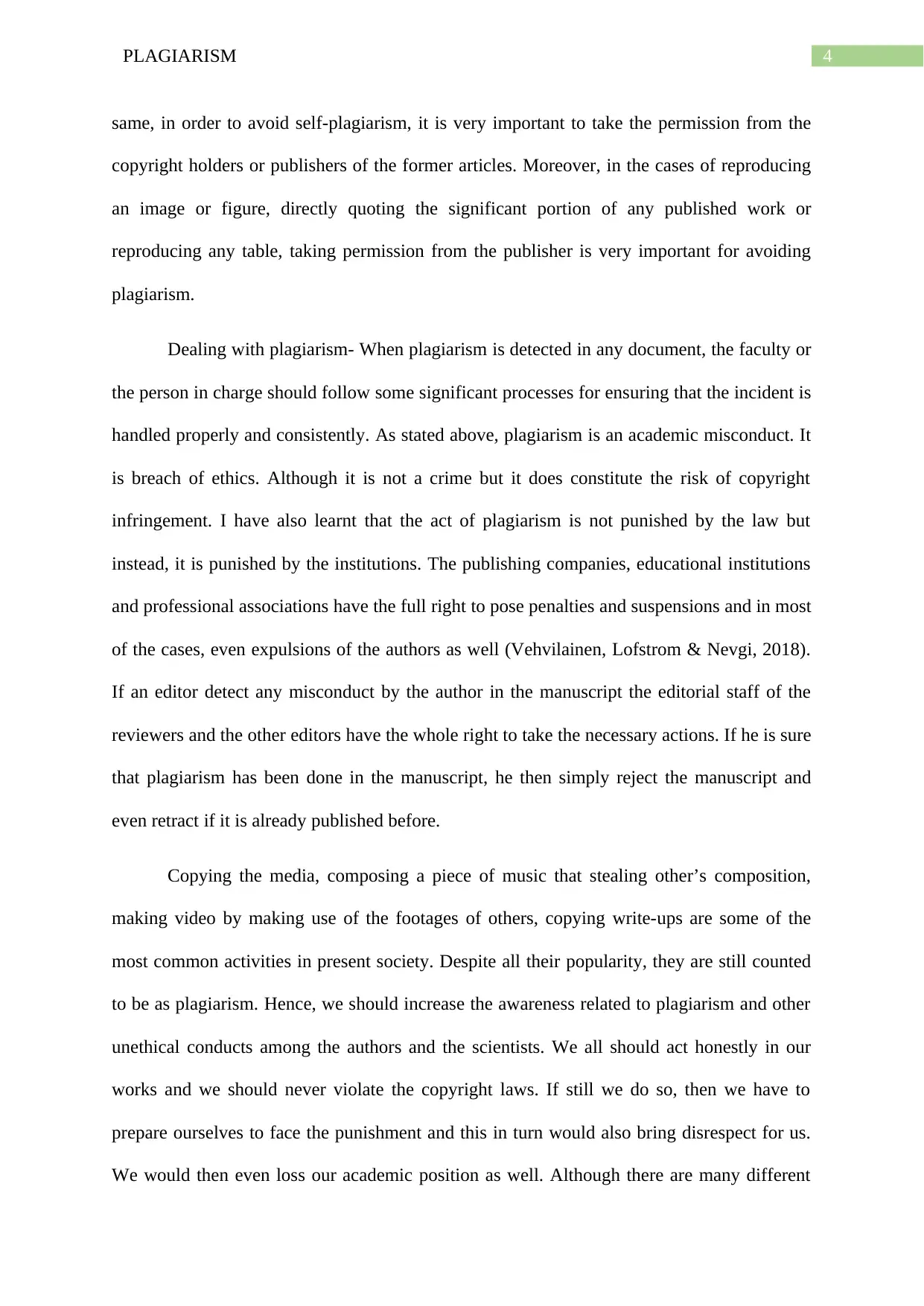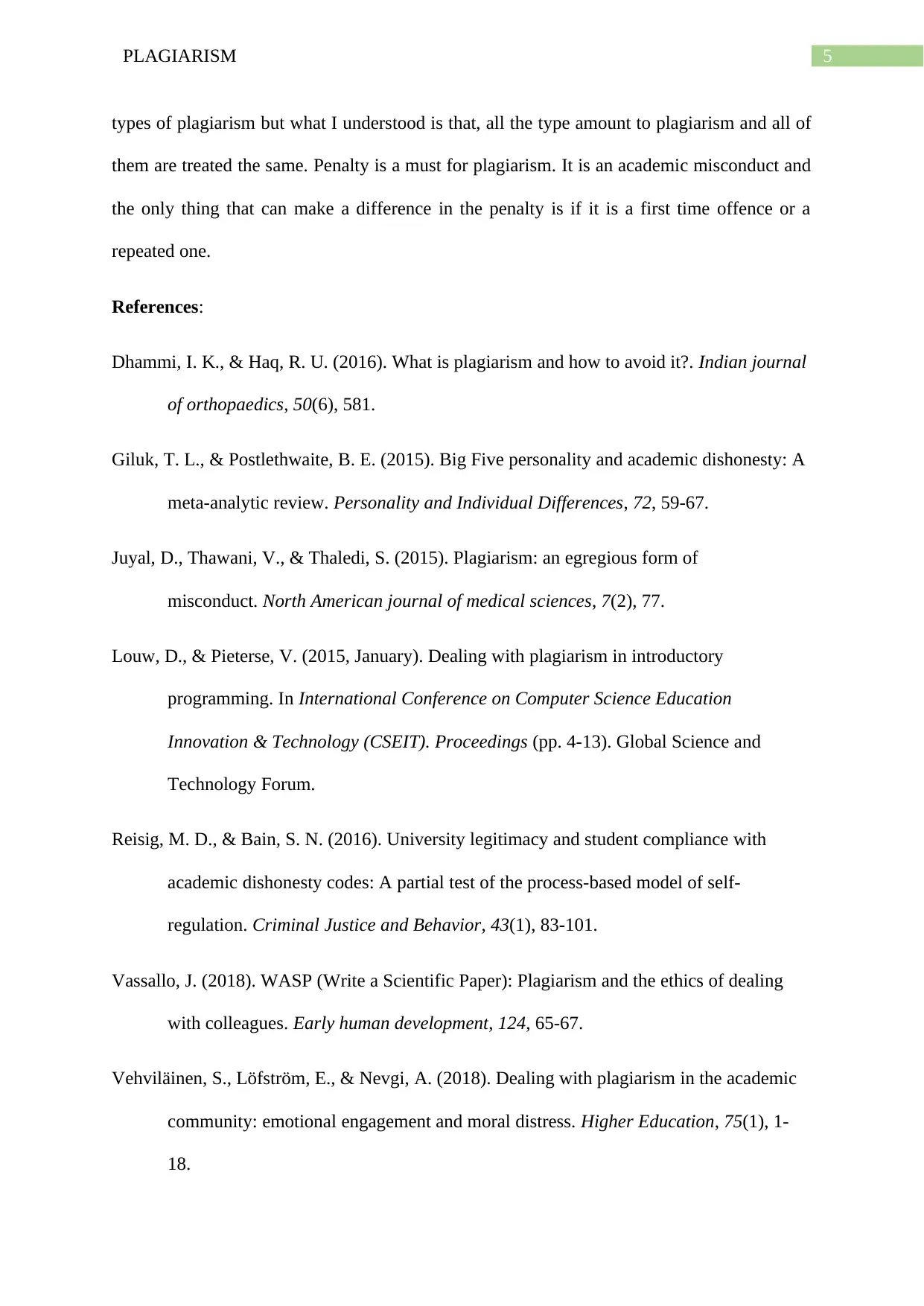Understanding and Avoiding Plagiarism: An Academic Essay
VerifiedAdded on 2023/04/24
|7
|2032
|186
Essay
AI Summary
This essay delves into the multifaceted issue of plagiarism, beginning with a clear definition and exploring various forms, including verbatim, mosaic, paraphrasing, self-plagiarism, cyber plagiarism, and image plagiarism. Drawing insights from the article "What is Plagiarism and how to avoid it?" by Ish Kumar Dhammi and Rehan UI Haq, the essay highlights the importance of ethical writing and proper citation. It further discusses methods for detecting plagiarism using online tools and the role of vigilant readers. The essay emphasizes strategies to avoid plagiarism, such as proper referencing, using quotation marks, and obtaining permissions, while also addressing the consequences of plagiarism, including institutional penalties and the importance of academic integrity. The author stresses the need for awareness and ethical conduct in academic and professional settings.

Running head: PLAGIARISM
Plagiarism
Name of the Student:
Name of the University:
Author note:
Plagiarism
Name of the Student:
Name of the University:
Author note:
Paraphrase This Document
Need a fresh take? Get an instant paraphrase of this document with our AI Paraphraser

1PLAGIARISM
Plagiarism is an academic dishonesty and is also commonly regarded to be as a
rampant vice among the students (Giluk & Postlethwaite, 2015). There is an ever increasing
concern regarding the increasing level of plagiarism among the college going students. There
are several forms of plagiarism exist and is quite tough for most of the students to master. For
example, copying from the other sources without giving them the credit or paraphrasing the
works of other and not acknowledging them are two of the most common forms of
plagiarism. However, in this paper, I shall demonstrate by understanding on plagiarism and
what I have learnt more on this from the article named “What is Plagiarism and how to avoid
it?” by Ish Kumar Dhammi and Rehan UI Haq. I shall further shed light on the different types
of plagiarism and how to detect and avoid them while writing manuscript.
Definition of plagiarism- From the article mentioned above, I learnt many things in
relation to plagiarism. As per Vehvilainen, Lofstrom and Nevgi (2018), plagiarism refers to
the unreferenced use of the published and unpolished works and ideas of other people. I have
learned very quickly that people can be pretty good at cheating. Plagiarism is something that
can take place at any stage of planning a write up, researching or publication. With the same,
even it is applied to the electronic and print versions as well. I have always thought of
plagiarism to be a wrongful appropriation (Reisig & Bain, 2016). To me, it is something
equal to stealing. Most of us use to think of plagiarism as copying or borrowing the ideas and
work of other people. However, these terms like “borrowing” and “copying” just disguise the
seriousness of this offense. Plagiarism is simply an act of fraud.
Types of plagiarism- There are several different forms of plagiarism and they are-
verbatim plagiarism, mosaic plagiarism, and paraphrasing, self-plagiarism, Image plagiarism
and cyber plagiarism (Dhammi & Haq, 2016). Firstly, the verbatim plagiarism is when we
use other people’s written words in our own name and do not acknowledge them in any way.
One of the most common form of verbatim plagiarism is when we copy and paste the
Plagiarism is an academic dishonesty and is also commonly regarded to be as a
rampant vice among the students (Giluk & Postlethwaite, 2015). There is an ever increasing
concern regarding the increasing level of plagiarism among the college going students. There
are several forms of plagiarism exist and is quite tough for most of the students to master. For
example, copying from the other sources without giving them the credit or paraphrasing the
works of other and not acknowledging them are two of the most common forms of
plagiarism. However, in this paper, I shall demonstrate by understanding on plagiarism and
what I have learnt more on this from the article named “What is Plagiarism and how to avoid
it?” by Ish Kumar Dhammi and Rehan UI Haq. I shall further shed light on the different types
of plagiarism and how to detect and avoid them while writing manuscript.
Definition of plagiarism- From the article mentioned above, I learnt many things in
relation to plagiarism. As per Vehvilainen, Lofstrom and Nevgi (2018), plagiarism refers to
the unreferenced use of the published and unpolished works and ideas of other people. I have
learned very quickly that people can be pretty good at cheating. Plagiarism is something that
can take place at any stage of planning a write up, researching or publication. With the same,
even it is applied to the electronic and print versions as well. I have always thought of
plagiarism to be a wrongful appropriation (Reisig & Bain, 2016). To me, it is something
equal to stealing. Most of us use to think of plagiarism as copying or borrowing the ideas and
work of other people. However, these terms like “borrowing” and “copying” just disguise the
seriousness of this offense. Plagiarism is simply an act of fraud.
Types of plagiarism- There are several different forms of plagiarism and they are-
verbatim plagiarism, mosaic plagiarism, and paraphrasing, self-plagiarism, Image plagiarism
and cyber plagiarism (Dhammi & Haq, 2016). Firstly, the verbatim plagiarism is when we
use other people’s written words in our own name and do not acknowledge them in any way.
One of the most common form of verbatim plagiarism is when we copy and paste the

2PLAGIARISM
published articles without doing any referencing. Secondly, the mosaic plagiarism refers to
the type of plagiarism in which each and every words are not copied but it involves mixing
our own words in other’s opinions, works or ideas. Thirdly, paraphrasing is one of the most
common type of plagiarism. It is when we rewrite any particular paragraph in our own words.
In this case, we just change few words of the original sentences. Changing few words alone
do not make the whole thing as our own writing. If the original authors or writers are not
acknowledged and if it is not referenced, then it would amount to plagiarism.
Fourthly, self-plagiarism refers to the use of our own earlier work in another context
in absence of citing that it was already used formerly. However, in this form, the main idea is
that we, as the writers, should let out readers know that it was not the very first use of the
material that they are reading. Republishing the text is one of the most common example of
this type of plagiarism. It is also to mention that self-plagiarism is further divided into four
different types and they are- a) duplicate publication, b) augmented publication, c) segmented
publication and, d) text recycling. Duplicate publication is when we submit same manuscript
to two different journals (Juyal, Thawani & Thaledi, 2015). It is a serious offence and in such
cases, the editor could take any action as per the COPE flowchart. On the other hand, the
augmented publication is when we add more data to our formerly published words and
modifies the aim of that study in any way. Thirdly, the segmented publication is when two or
more papers are derived from similar research works. Lastly, text recycling, as the name itself
suggest, is the act when we use huge part of our own published text in our new written
manuscript. It can easily be detected by the plagiarism software. Moreover, as per (), cyber
plagiarism on the other hand can be defined as “downloading or copying in part, or in their
entirety, articles or research papers found on the Internet or copying ideas found on the Web
and not giving proper attribution”. Lastly, the image plagiarism refers to the type of
published articles without doing any referencing. Secondly, the mosaic plagiarism refers to
the type of plagiarism in which each and every words are not copied but it involves mixing
our own words in other’s opinions, works or ideas. Thirdly, paraphrasing is one of the most
common type of plagiarism. It is when we rewrite any particular paragraph in our own words.
In this case, we just change few words of the original sentences. Changing few words alone
do not make the whole thing as our own writing. If the original authors or writers are not
acknowledged and if it is not referenced, then it would amount to plagiarism.
Fourthly, self-plagiarism refers to the use of our own earlier work in another context
in absence of citing that it was already used formerly. However, in this form, the main idea is
that we, as the writers, should let out readers know that it was not the very first use of the
material that they are reading. Republishing the text is one of the most common example of
this type of plagiarism. It is also to mention that self-plagiarism is further divided into four
different types and they are- a) duplicate publication, b) augmented publication, c) segmented
publication and, d) text recycling. Duplicate publication is when we submit same manuscript
to two different journals (Juyal, Thawani & Thaledi, 2015). It is a serious offence and in such
cases, the editor could take any action as per the COPE flowchart. On the other hand, the
augmented publication is when we add more data to our formerly published words and
modifies the aim of that study in any way. Thirdly, the segmented publication is when two or
more papers are derived from similar research works. Lastly, text recycling, as the name itself
suggest, is the act when we use huge part of our own published text in our new written
manuscript. It can easily be detected by the plagiarism software. Moreover, as per (), cyber
plagiarism on the other hand can be defined as “downloading or copying in part, or in their
entirety, articles or research papers found on the Internet or copying ideas found on the Web
and not giving proper attribution”. Lastly, the image plagiarism refers to the type of
⊘ This is a preview!⊘
Do you want full access?
Subscribe today to unlock all pages.

Trusted by 1+ million students worldwide

3PLAGIARISM
plagiarism that are done using images and videos without receiving proper permission and
providing proper citation.
Detecting plagiarism- Detection of plagiarism refers to the process of locating the
instances of plagiarism in any work or write-up. The high use of internet and computers in
contemporary world has made it very easier to plagiarise other people works. Although it is a
highly intolerable action in the digital community, academic career and literary community,
still it is done by the people. It is a practice that all the reputable companies and individuals
try their best to avoid (Vassallo, 2018). There are certain websites made available by the
information technology for the common writers that can detect plagiarism. Some of the most
common of them are the www.plagiarism.org, www.turnitin.com, www.ithentical.com etc.
The other learned readers and watchful viewers can also detect plagiarism because of their
familiarity with the already published material that they have read to seen earlier.
Avoiding plagiarism- In most of the cases, plagiarism could be avoided by citing the
sources from where the materials are taken, by simply acknowledging that there are some
materials that has been borrowed or by providing the readers with all the details and
information that are required for finding that the source is enough for preventing the
plagiarism. As stated above, using any piece of music, video or image in our work that we
have produced in absence of receiving appropriate permission and providing proper citation
is also plagiarism. All these can be avoided by simply practising ethical and honest writing.
Keeping honesty in all the writings and crediting the original sources are very important.
When we fail to do this, we commit plagiarism and that is a serious offense (Zhang, 2016). In
these days, this conduct is considered to be a serious issue in the world of academics. To
avoid this, one should attribute the references, provide footnotes, make use of quotation
marks when required, and give proper acknowledgement to the original writer and at the
same time, give all the source of information as well (Louw & Pieterse, 2015). With the
plagiarism that are done using images and videos without receiving proper permission and
providing proper citation.
Detecting plagiarism- Detection of plagiarism refers to the process of locating the
instances of plagiarism in any work or write-up. The high use of internet and computers in
contemporary world has made it very easier to plagiarise other people works. Although it is a
highly intolerable action in the digital community, academic career and literary community,
still it is done by the people. It is a practice that all the reputable companies and individuals
try their best to avoid (Vassallo, 2018). There are certain websites made available by the
information technology for the common writers that can detect plagiarism. Some of the most
common of them are the www.plagiarism.org, www.turnitin.com, www.ithentical.com etc.
The other learned readers and watchful viewers can also detect plagiarism because of their
familiarity with the already published material that they have read to seen earlier.
Avoiding plagiarism- In most of the cases, plagiarism could be avoided by citing the
sources from where the materials are taken, by simply acknowledging that there are some
materials that has been borrowed or by providing the readers with all the details and
information that are required for finding that the source is enough for preventing the
plagiarism. As stated above, using any piece of music, video or image in our work that we
have produced in absence of receiving appropriate permission and providing proper citation
is also plagiarism. All these can be avoided by simply practising ethical and honest writing.
Keeping honesty in all the writings and crediting the original sources are very important.
When we fail to do this, we commit plagiarism and that is a serious offense (Zhang, 2016). In
these days, this conduct is considered to be a serious issue in the world of academics. To
avoid this, one should attribute the references, provide footnotes, make use of quotation
marks when required, and give proper acknowledgement to the original writer and at the
same time, give all the source of information as well (Louw & Pieterse, 2015). With the
Paraphrase This Document
Need a fresh take? Get an instant paraphrase of this document with our AI Paraphraser

4PLAGIARISM
same, in order to avoid self-plagiarism, it is very important to take the permission from the
copyright holders or publishers of the former articles. Moreover, in the cases of reproducing
an image or figure, directly quoting the significant portion of any published work or
reproducing any table, taking permission from the publisher is very important for avoiding
plagiarism.
Dealing with plagiarism- When plagiarism is detected in any document, the faculty or
the person in charge should follow some significant processes for ensuring that the incident is
handled properly and consistently. As stated above, plagiarism is an academic misconduct. It
is breach of ethics. Although it is not a crime but it does constitute the risk of copyright
infringement. I have also learnt that the act of plagiarism is not punished by the law but
instead, it is punished by the institutions. The publishing companies, educational institutions
and professional associations have the full right to pose penalties and suspensions and in most
of the cases, even expulsions of the authors as well (Vehvilainen, Lofstrom & Nevgi, 2018).
If an editor detect any misconduct by the author in the manuscript the editorial staff of the
reviewers and the other editors have the whole right to take the necessary actions. If he is sure
that plagiarism has been done in the manuscript, he then simply reject the manuscript and
even retract if it is already published before.
Copying the media, composing a piece of music that stealing other’s composition,
making video by making use of the footages of others, copying write-ups are some of the
most common activities in present society. Despite all their popularity, they are still counted
to be as plagiarism. Hence, we should increase the awareness related to plagiarism and other
unethical conducts among the authors and the scientists. We all should act honestly in our
works and we should never violate the copyright laws. If still we do so, then we have to
prepare ourselves to face the punishment and this in turn would also bring disrespect for us.
We would then even loss our academic position as well. Although there are many different
same, in order to avoid self-plagiarism, it is very important to take the permission from the
copyright holders or publishers of the former articles. Moreover, in the cases of reproducing
an image or figure, directly quoting the significant portion of any published work or
reproducing any table, taking permission from the publisher is very important for avoiding
plagiarism.
Dealing with plagiarism- When plagiarism is detected in any document, the faculty or
the person in charge should follow some significant processes for ensuring that the incident is
handled properly and consistently. As stated above, plagiarism is an academic misconduct. It
is breach of ethics. Although it is not a crime but it does constitute the risk of copyright
infringement. I have also learnt that the act of plagiarism is not punished by the law but
instead, it is punished by the institutions. The publishing companies, educational institutions
and professional associations have the full right to pose penalties and suspensions and in most
of the cases, even expulsions of the authors as well (Vehvilainen, Lofstrom & Nevgi, 2018).
If an editor detect any misconduct by the author in the manuscript the editorial staff of the
reviewers and the other editors have the whole right to take the necessary actions. If he is sure
that plagiarism has been done in the manuscript, he then simply reject the manuscript and
even retract if it is already published before.
Copying the media, composing a piece of music that stealing other’s composition,
making video by making use of the footages of others, copying write-ups are some of the
most common activities in present society. Despite all their popularity, they are still counted
to be as plagiarism. Hence, we should increase the awareness related to plagiarism and other
unethical conducts among the authors and the scientists. We all should act honestly in our
works and we should never violate the copyright laws. If still we do so, then we have to
prepare ourselves to face the punishment and this in turn would also bring disrespect for us.
We would then even loss our academic position as well. Although there are many different

5PLAGIARISM
types of plagiarism but what I understood is that, all the type amount to plagiarism and all of
them are treated the same. Penalty is a must for plagiarism. It is an academic misconduct and
the only thing that can make a difference in the penalty is if it is a first time offence or a
repeated one.
References:
Dhammi, I. K., & Haq, R. U. (2016). What is plagiarism and how to avoid it?. Indian journal
of orthopaedics, 50(6), 581.
Giluk, T. L., & Postlethwaite, B. E. (2015). Big Five personality and academic dishonesty: A
meta-analytic review. Personality and Individual Differences, 72, 59-67.
Juyal, D., Thawani, V., & Thaledi, S. (2015). Plagiarism: an egregious form of
misconduct. North American journal of medical sciences, 7(2), 77.
Louw, D., & Pieterse, V. (2015, January). Dealing with plagiarism in introductory
programming. In International Conference on Computer Science Education
Innovation & Technology (CSEIT). Proceedings (pp. 4-13). Global Science and
Technology Forum.
Reisig, M. D., & Bain, S. N. (2016). University legitimacy and student compliance with
academic dishonesty codes: A partial test of the process-based model of self-
regulation. Criminal Justice and Behavior, 43(1), 83-101.
Vassallo, J. (2018). WASP (Write a Scientific Paper): Plagiarism and the ethics of dealing
with colleagues. Early human development, 124, 65-67.
Vehviläinen, S., Löfström, E., & Nevgi, A. (2018). Dealing with plagiarism in the academic
community: emotional engagement and moral distress. Higher Education, 75(1), 1-
18.
types of plagiarism but what I understood is that, all the type amount to plagiarism and all of
them are treated the same. Penalty is a must for plagiarism. It is an academic misconduct and
the only thing that can make a difference in the penalty is if it is a first time offence or a
repeated one.
References:
Dhammi, I. K., & Haq, R. U. (2016). What is plagiarism and how to avoid it?. Indian journal
of orthopaedics, 50(6), 581.
Giluk, T. L., & Postlethwaite, B. E. (2015). Big Five personality and academic dishonesty: A
meta-analytic review. Personality and Individual Differences, 72, 59-67.
Juyal, D., Thawani, V., & Thaledi, S. (2015). Plagiarism: an egregious form of
misconduct. North American journal of medical sciences, 7(2), 77.
Louw, D., & Pieterse, V. (2015, January). Dealing with plagiarism in introductory
programming. In International Conference on Computer Science Education
Innovation & Technology (CSEIT). Proceedings (pp. 4-13). Global Science and
Technology Forum.
Reisig, M. D., & Bain, S. N. (2016). University legitimacy and student compliance with
academic dishonesty codes: A partial test of the process-based model of self-
regulation. Criminal Justice and Behavior, 43(1), 83-101.
Vassallo, J. (2018). WASP (Write a Scientific Paper): Plagiarism and the ethics of dealing
with colleagues. Early human development, 124, 65-67.
Vehviläinen, S., Löfström, E., & Nevgi, A. (2018). Dealing with plagiarism in the academic
community: emotional engagement and moral distress. Higher Education, 75(1), 1-
18.
⊘ This is a preview!⊘
Do you want full access?
Subscribe today to unlock all pages.

Trusted by 1+ million students worldwide

6PLAGIARISM
Zhang, Y. H. (2016). Dealing with Plagiarism as an Editor. In Against Plagiarism (pp. 123-
138). Springer, Cham.
Zhang, Y. H. (2016). Dealing with Plagiarism as an Editor. In Against Plagiarism (pp. 123-
138). Springer, Cham.
1 out of 7
Related Documents
Your All-in-One AI-Powered Toolkit for Academic Success.
+13062052269
info@desklib.com
Available 24*7 on WhatsApp / Email
![[object Object]](/_next/static/media/star-bottom.7253800d.svg)
Unlock your academic potential
Copyright © 2020–2025 A2Z Services. All Rights Reserved. Developed and managed by ZUCOL.




